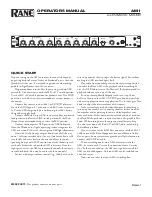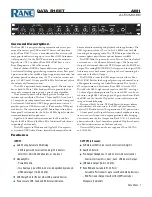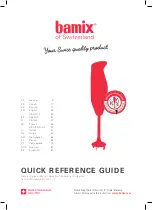
The Communications Module.
The talk system is very simple, fast and flexible; one button press selects the source from a choice of talk
mic, pink noise generator, swept oscillator or external input; a second button press routes the signals to any
of the mix outputs. An external output is also provided to connect to other systems. Internal console signals
can be monitored via a powerful 8 watt headphone amplifier or via speakers under control from the 100mm
local output fader.
The Solo System.
The XL250 has an advanced solo system which operates in two main modes; auto cancel and input priority
add mode. The auto cancel mode allows fast access channels and groups by removing the need to cancel
previous solos. The add mode allows the building of solo scenes when many solos can be placed on to the
solo buses at the same time; inputs are given priority over groups, i.e. any active input channel solo will
Automutes.
The XL250 has 8 automute masters which can be assigned to any input or group and act on pre fader and
post fader signals. These are overlapping and allow easy muting of unwanted instruments during a
performance. Each module has a safe switch which can be used to over ride the automute system.
Outputs and Meters.
All outputs including insert sends can drive large capacitive loads and feature semi-floating fully balanced
circuits which are both differential and common mode impedance matched. All the mix group outputs are
monitored post fader by 20 led peak reading meters which cover a 60dB range in 3dB steps.
Mix Groups with Direct Inputs.
The 20 mix groups feature 100mm faders and can be used directly for speaker outputs or as audio sub
groups with groups 1 to 18 feeding the stereo master (groups 19 and 20) via individual pan controls and
on/off switches. Each mix group also has a direct input with level control which can be routed into the mix
group either pre or post insert point. This can be used to link consoles, return effects, bring in sub mixes or
taped material etc.
Audio Busses.
The XL250 has 4 fixed busses, 2 aux busses for effects sends and a stereo master bus. The aux busses have
independent on/off switching and pre/post fader switching. The remaining 16 busses are configured on a
bus by bus basis as mono or stereo. The channel mix controls that feed these busses automatically change
from level and level to level and pan with the push of a switch on the group modules. As an extreme this
gives 18 independent mono busses with a stereo master bus or 2 mono aux busses with 9 independent stereo
busses. Dual concentric type controls have not been used on any of the bus sends. This simplifies
adjustment and viewing of relative levels within the mix. All the configurable mix sends feature independent
on/off switching and pre/post fader switching.
temporarily override an active group solo. In auto cancel mode, stereo and other multiple channels or groups
can be soloed together providing they are switched on at the same time. This saves switching back and forth
between the two modes. In either mode the solo switches are only latching in operation if they are pressed
for under a second, if they are held for longer than this they unlatch and the solo will cancel when the switch
is finally released. The solo system can operate as PFL mono, AFL stereo or solo in place which operates on
the stereo master output.






































